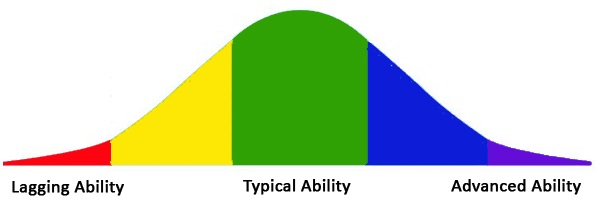Helping Kids Whose Behavior Is Not Normal
by Kathy Slattengren, M. Ed., Priceless Parenting (sign up for monthly parenting newsletter and receive 20+ printable charts for kids and parents)
(listen to article read by the author)

Is your child developmentally on track? It can be hard to know if you don’t have many other similarly aged children for comparison. Teachers, pediatricians, and child psychologists can provide insight based on all the other children they see.
Although all children are on a similar developmental path, they progress in their own way. Some babies are walking at 6 months and others not until 18 months. As long as your child is walking by 18 months, there is no reason for concern.
Your child’s developmental milestones can be looked at on a bell curve. Your child may excel in one area but be behind in another area. For example, maybe your child can read but doesn’t play with other kids.
Considering Your Child’s Abilities
Understanding typical developmental milestones can help you recognize when your child may need help. The
Centers for Disease Control (CDC) has information on what most children can do at certain ages. They also tell you what to do if you are concerned about your child’s development.
The CDC lists specific milestones in four developmental areas for ages 2 months – 5-years-old:
- Social/Emotional
- Cognitive (learning, thinking, problem-solving)
- Language/Communication
- Movement/Physical
Each area lists what a child of that age can typically do. For example, a 4-year-old typically can cooperate with other kids, tell stories, understand the idea of counting, and hop on one foot for up to 2 seconds. Ages 6 to 17 only include the social/emotional and cognitive categories.
How is your child’s development in each area? Do you feel they are typical, advanced or behind? If your child is advanced in one area and lagging in another, this is called asynchronous development. For example, a 10-year-old may have the cognitive skills of a 13-year-old and the social skills of a 6-year-old.
These are some of the most difficult kids to parent. These kids may have advanced reasoning and negotiating skills along with fierce tantrums. They do not act their age. When they act much younger than their age, you must respond based on where they are, not where a typical child would be.
Understanding your children’s unique set of characteristics allows you to provide the support they need to blossom. One mom’s daughter was exceptionally bright and put into a high achiever program. However, the daughter also had delayed social skills and anxiety. The program was too stressful for her. Although the girl was excelling academically, the mom decided to pull her out of the program.
Getting Help For Your Child
Do your child’s lagging skills require intervention? Or is it just quirky behavior that makes your child who they are? If their behavior is not causing significant problems for themselves or others, you can probably let it go.
What if you feel their behavior is cause for concern? How do you help your child where they are struggling with things typical kids find easy? Do they need counseling, occupational therapy, medication or just more time to learn these skills?
When your child’s development is atypical, you become a detective trying to figure out the best path forward. Children with complex physical and psychological symptoms can baffle the best of doctors. Your child might get different diagnoses and treatments from different doctors. Each doctor looks at your child through their lens of expertise.
If you are fortunate, the doctor’s expertise matches your child’s needs. However, many parents struggle for years to find doctors who can truly help their child.
Dr. Kenneth Bock describes helping emotionally struggling kids in his book,
Brain Inflamed: Uncovering the Hidden Causes of Anxiety, Depression, and Other Mood Disorders in Adolescents and Teens. His brilliance lies in detecting problems in a child’s immune system that have led to symptoms like irritability, depression, brain fog, rage, school phobia, insomnia, and anxiety. Many of the children he treats have suffered for years due to underlying immune system issues not being resolved.
One case he discusses is Georgia, a 10-year-old girl, who went from enjoying school and sports to refusing to go to school. She was terrified of leaving her mom, needed to perform rituals, had frenzied fits, plus other bizarre behavior. These problems appeared after being treated for a strep infection.
Given Georgia’s continuing problems, her mom took her back to the pediatrician. Georgia tested negative for strep. The pediatrician felt this was normal childhood anxiety perhaps intensified by her mom. Despite this slam, Georgia’s mom did not give up. Eventually Georgia found help from Dr. Bock who diagnosed her with infection-triggered autoimmune brain inflammation (ITABI).
Georgia had a history of allergies, pneumonia, strep plus tested positive for Lyme disease. Solving her immune system’s dysfunction and resolving the infections took about six months. It was worth the effort as she got back to her old self.
Issues around social/emotional behavior are notoriously difficult to tackle. You are your child’s best advocate. Doctors are human and fallible. Finding help for your child can be a most difficult journey but one that pays off when your child’s physical and mental health is regained.